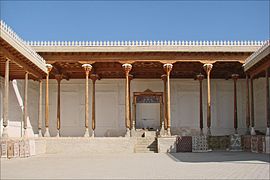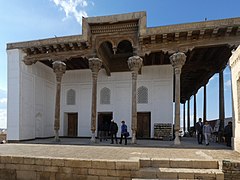Ark (Buxoro)
The Ark is a citadel in the Uzbek city of Buxoro . It served as the residence and seat of government of the khans and emirs of Buxoro.
location
The citadel is located in the historical center of Buxoro in the northwest of the old town on the Registan on an artificially raised hill about 20 meters high. Opposite the citadel to the west is the Bolo Hovuz Mosque . To the east of the citadel lies the Zindon , the former prison of Buxoro. To the south of the Ark are the Hodscha Zaynuddin complex and the Poi Kalon building complex .
history
The time when the Ark was built is unknown. According to legend, Siyawasch is considered to be the builder of the citadel. His grave is said to have been at the east gate. Excavations revealed traces from the 4th century BC.
Over the centuries the citadel was destroyed and rebuilt several times, most recently under the Scheibanids . Here was not only the ruler's palace, but a "city within the city" with state institutions such as B. the coin , apartments of high public servants, barracks and farm buildings such as storehouses, workshops, stables, etc.
When Bukhara was conquered by the Red Army in 1920, the wooden buildings went up in flames, and some were rebuilt according to historical plans.
description
The citadel extends over an area of about four hectares . It is surrounded by a massive fortress wall. Most of the site is in ruins.
A ramp leads from the Registan to a gate building with two round corner towers , a barred gallery above the gate and an open gallery supported by columns above. Behind the entrance, a tunnel leads past the former dungeon to the surface of the citadel.
The ruler's palace is a simple brick building. There is a museum for regional studies in it. The throne room is a paved courtyard, only some of the pillars supporting the roof remain from the former roof.
To the north of the palace is the Djami or Dschuma mosque (Friday mosque), which was built in 1712 and is open on three sides under Iwane . The open area was used as a summer mosque.
Mosque; left the mihrabniche of the summer mosque
literature
- Klaus Pander: Ark . In: Central Asia . 5th updated edition. DuMont Reiseverlag , 2004, ISBN 3-7701-3680-2 , chapter Bukhara, the noble , p. 147 ff . (DuMont art travel guide).
- Bradley Mayhew, Greg Bloom, John Noble, Dean Starnes: Ark and around . In: Central Asia . 5th edition. Lonely Planet , 2010, ISBN 978-1-74179-148-8 , chapter Bukhara , p. 261 f .
- Alexei Arapov: Bukhara . Masterpieces from Central Asia. SMI-ASIA, Tashkent 2015, ISBN 978-9943-17-073-5 , p. 96 to 98 .
- Alexey Arapov: The Historical Monuments of Uzbekistan . Tashkent Samarkand Bukhara Chiva Shahrisabz. SMI-ASIA, Tashkent 2016, ISBN 978-9943-17-075-9 , Bukhara, p. 55 .
Web links
- Ark Citadel, Bukhara at Advantour
- Djami Mosque, Bukhara at Advantour
- The Ark fortress at Doca Tours
- Ark at Lonelyplanet (English)
Coordinates: 39 ° 46 ′ 40.3 " N , 64 ° 24 ′ 37" E




